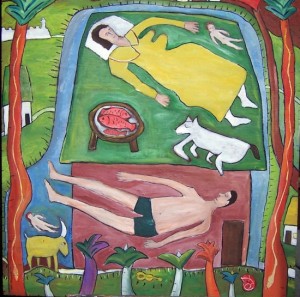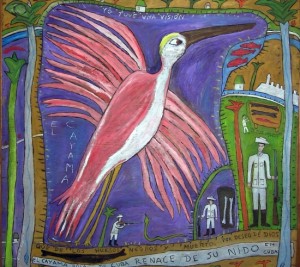 Corso de Palenzuela was born in Havana, Cuba, at Quinta Covadonga into a prominent Spanish aristocratic family of bankers, jewelers, diamond merchants, distinguished clergy, and landowners of aristocratic Sephardic ancestry.
Corso de Palenzuela was born in Havana, Cuba, at Quinta Covadonga into a prominent Spanish aristocratic family of bankers, jewelers, diamond merchants, distinguished clergy, and landowners of aristocratic Sephardic ancestry.
Like many cubans in the United States, his family, disgusted with Batista’s corruption, was drawn to Castro’s promise of a better life for all Cubans. They often entertained Castro at their beautiful estate. But, when things started to unravel in their beloved country, they decided to leave. Mr. de Palenzuela was eight years old. He began painting at the age of ten.
Corso de Palenzuela, known simply as Corso, creates imaginative and idiosyncratic scenes that are painted in oil on plywood and cardboard-often enhanced with symbolism derived from Spanish-Hebraic mysticism and visions from his childhood experience. Soon after he began painting, the Cuban-born artist Ana Mendieta discovered Corso’s artwork.
Conversant in three languages, Corso has traveled to over 20 countries. De Palenzuela, the vibrant outsider artist is a self-taught artist who has worked for over twenty years exploring his memories of his native land. Wood, cardboard, plywood and other found surfaces are transformed into colorful images of people set in places with a wide array of flora and fauna. These personal images float on the surface, and are enhanced with symbolism derived from Spanish-Hebraic mysticism and visions from his childhood experiences, depicting his family, people and the geography of places in Cuba that he recalls.
Arts Work.

“The Hut”, El Bohio, is a large 32″x 34″ primary color painting of oil on board, populated with a mother and father napping, two children floating on the scene, a platter of fish, palm trees, a dog, a goat, a snake and a snail – all elements that create a kind of dreamlike, floating home that is so appealing. Calling us to relax and let go of our complicated lives, “The Hut” evokes a kind of peace of mind that reminds us that the essentials for life are simple indeed. The artist is a visual storyteller whose inspiration comes from both natural and spiritual forces.
The birds he paints are imbued with a kind of mystical power. His exotic Woodpeckers, Kingfishers, Hummingbird, his White Peacock and the extinct Cuban stork, Il Cayama, are larger than life and seem more like icons of some supernatural handiwork that beg for reverence.
The self-taught outsider artist describes himself as obsessive, and this trait comes out in his selections chosen for this exhibition. Corso’s obsession: Cuba, and he devotes his vision to depictions of his mother country. All of his paintings in the show, and most of his artwork, are set in the context of Cuba, or about Cuba. Many of these depict birds, dogs, or other animals.
Cubata, pronounced with the accent on the last syllable, is the term used by the artist to describe the aesthetic essence of his work. Self-referential, Cubata speaks of his intense affection for the Cuba of his childhood. In his own words, “Cubata is the beautiful and the ugly. Cubata is life and death.”
Corso is also an international restaurant critic, food, wine, beer, and chocolate connoisseur and chef who has written extensively on food and wine for leading world publications.
Corso de Palenzuela resides in the Hudson Valley and Virginia.
Agencies/Various/Wiki/InternetPhotos/youtube/thecubanhistory.com
The Cuban History, Hollywood.
Arnoldo Varona, Editor.



 Baron Corso de Palenzuela, painter, restaurant critic. (born in Havana)
Baron Corso de Palenzuela, painter, restaurant critic. (born in Havana)